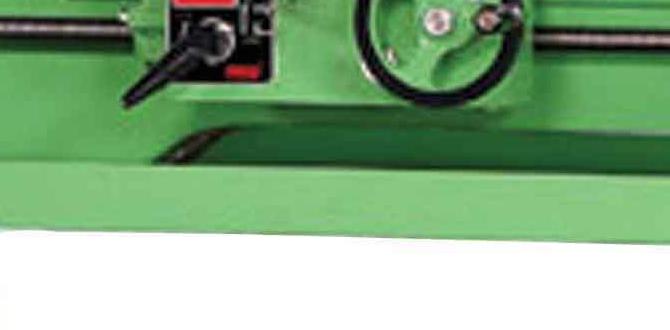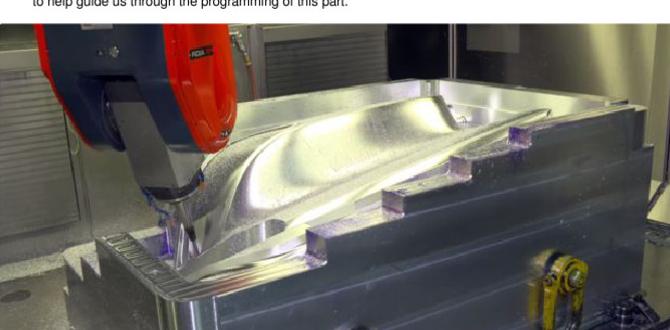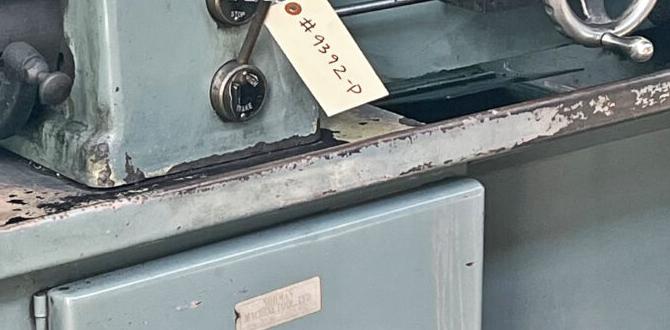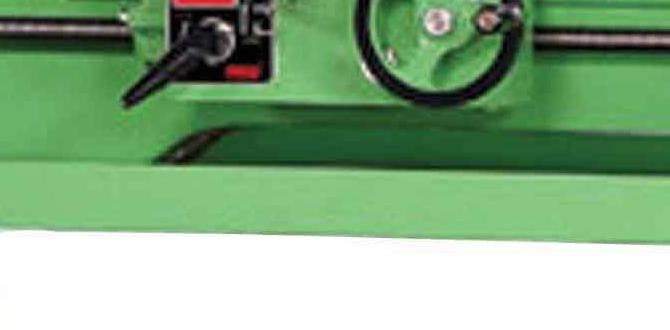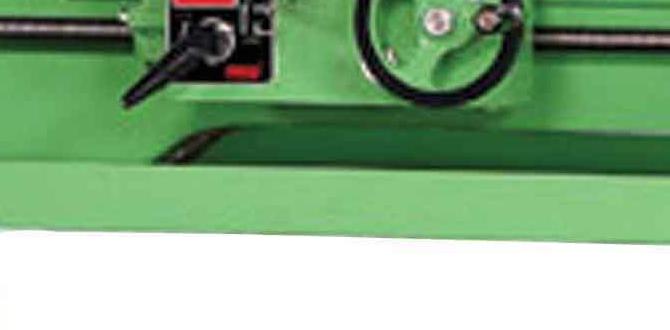A 1/8 inch carbide end mill is your go-to tool for clean, efficient copper cutting. Its precision and durability make it ideal for hobbyists and professionals alike, ensuring smooth cuts and excellent results without snagging or chipping the soft metal.
Hey there, fellow makers! Daniel Bates here from Lathe Hub. Ever tried cutting copper on your milling machine and ended up with a gummy, torn-up mess? It’s a frustrating problem many beginners face. Copper is a soft metal, and using the wrong tool can lead to sticky chips, dull cutters, and a whole lot of head-scratching. But don’t worry! The solution is often simpler than you think, and it comes down to choosing the right tool for the job. Today, we’re diving deep into the world of the 1/8 inch carbide end mill, specifically for cutting copper. We’ll break down exactly why it works so well and how you can achieve those clean, precise cuts you’re after.
Carbide End Mill 1/8 Inch: Your Secret Weapon for Cutting Copper
Copper is a fantastic material for many projects, from intricate jewelry to functional electronic components and decorative art. Its conductivity, malleability, and attractive appearance make it a popular choice for hobbyists and professionals. However, working with copper on a milling machine can be tricky. Its softness means it can easily gum up cutting tools, leading to poor surface finish, tool breakage, and frustration. This is where the humble 1/8 inch carbide end mill shines.
When you’re looking for the best tool for the job, especially for soft and gummy materials like copper, your choice of end mill is critical. A standard steel end mill might seem like a good idea, but it often bonds with the softer metal, creating a sticky mess that’s hard to manage. Carbide, on the other hand, offers superior hardness and heat resistance. For a 1/8 inch diameter, which is perfect for detailed work and smaller machines, carbide is often the best bet. Let’s explore why this specific tool is so essential for copper cutting.
Why a 1/8 Inch Carbide End Mill is Perfect for Copper
Copper presents a unique challenge for machinists. It’s soft, ductile, and sticky. This means that as you cut, the copper chips tend to stick to the cutting edges of your tool. This buildup, known as “built-up edge” (BUE), can rapidly dull the cutter, lead to poor tolerances, and create a rough surface finish. It can also cause excessive vibration, potentially damaging your workpiece or your machine.
Here’s why a 1/8 inch carbide end mill is the ideal solution:
Superior Hardness and Heat Resistance
Carbide, also known as tungsten carbide, is an extremely hard material. This hardness allows it to cut through tougher materials and resist wear much better than high-speed steel (HSS). For copper, this means the cutting edges stay sharp for longer, reducing the tendency for the copper to stick. Carbide also has a higher melting point and better heat resistance, which is crucial because cutting operations generate heat. Even though copper isn’t as abrasive as some metals, efficient chip evacuation and sharp tools are still paramount, and carbide’s properties aid this significantly.
Optimized Geometry for Soft Metals
Many carbide end mills designed for non-ferrous metals (like copper, aluminum, and plastics) feature specific geometries. These often include:
High Rake Angles: A positive rake angle helps to shear the material cleanly, reducing cutting forces and the likelihood of the copper adhering to the tool.
Polished Flutes: Smooth, polished flute surfaces help chips flow away from the cutting edge more easily, further preventing material buildup.
Fewer Flutes: End mills for softer metals often have fewer flutes (e.g., 2 or 3 flutes) compared to those for harder metals (which might have 4 or more). This provides more chip room, essential for managing the larger, stickier chips produced when cutting copper. A 1/8 inch end mill with 2 flutes is a very common and effective choice for copper.
Understanding 1/8 Inch Carbide Specs for Copper
When you’re shopping for a 1/8 inch carbide end mill for copper, you’ll see a few key specifications that matter:
Diameter: This is your cutting width, in this case, 1/8 inch (approximately 3.175 mm). This size is great for detail work.
Shank Diameter: This is the diameter of the part of the tool that goes into your collet or holder. For a 1/8 inch cutter, the shank is typically the same, 1/8 inch (often referred to as a 6mm shank for metric compatibility, which is very common). Using a matching shank size ensures a solid grip.
Length: Total length and flute length. For detail work, a standard length is usually fine. Shorter flute lengths can sometimes offer more rigidity.
Number of Flutes: As mentioned, 2 or 3 flutes are generally best for copper.
Coating: While not always necessary for copper, certain coatings can improve performance and tool life. However, uncoated, highly polished carbide end mills are often excellent for non-ferrous materials.
Material Grade: Different carbide grades exist. For general machining of copper, a standard, fine-grain carbide is suitable.
“MQL Friendly”: This is a crucial spec for working with copper. MQL stands for Minimum Quantity Lubrication. It means the end mill is designed to work effectively with a very small amount of coolant or lubricant sprayed directly onto the cutting zone. This helps to keep the copper from gumming up the tool and also dissipates heat. Many modern carbide end mills are MQL friendly, featuring internal coolant channels or specific flute geometries that facilitate this.
Keyword Spotlight: “Carbide End Mill 1/8 Inch 6mm Shank Standard Length for Copper MQL Friendly”
This specific search term hits all the key points for someone looking for the ideal tool.
Carbide End Mill: Specifies the material and tool type.
1/8 Inch: The critical cutting diameter for detailed work.
6mm Shank: A common and practical shank size that ensures compatibility with many collet systems.
Standard Length: Indicates a common, versatile tool length suitable for most general milling tasks.
for Copper: Directly targets the material being machined.
MQL Friendly: Highlights a feature that is highly beneficial for cutting soft, gummy metals like copper, promoting better chip evacuation and cooler cutting.
Setting Up Your Mill for Copper Cutting
Before you even think about cutting, proper setup is key. This includes securing your workpiece firmly and ensuring your milling machine is ready to go.
Workpiece Clamping
Copper is soft and can be easily deformed. Ensure your workpiece is held securely in a vise or with clamps. Avoid over-tightening, which can distort the material, especially with thinner sheets. For delicate work, consider using soft jaws in your vise to protect the surface of the copper.
Machine Settings: Spindle Speed and Feed Rate
This is where many beginners stumble. Copper requires different speeds and feeds than steel or aluminum.
Spindle Speed (RPM): Generally, you’ll want to run copper at a relatively high spindle speed. This is because copper has a low melting point and can easily deform. Higher RPMs allow the tool to efficiently shear the material before it has a chance to deform and build up on the cutter. A good starting point for a 1/8 inch carbide end mill in copper might be in the range of 10,000 to 20,000 RPM, but this can vary based on your machine’s capabilities and the specific end mill.
Feed Rate (IPM or mm/min): The feed rate is how fast the cutter moves through the material. For copper, you want a feed rate that allows the tool to shear the material cleanly without rubbing. Too slow a feed rate at high RPM can lead to rubbing and heat buildup, while too fast can overload the tool. A starting point might be around 10-20 inches per minute (IPM) or 250-500 mm/min, but again, this is highly dependent on depth of cut and machine rigidity.
The relationship between spindle speed and feed rate is critical. It’s often expressed as the “chip load,” which is the thickness of material removed by each cutting edge per revolution. For copper, you want a chip load that encourages shearing rather than rubbing.
A typical starting point for a 1/8 inch 2-flute carbide end mill in copper might be:
Spindle Speed (RPM): 15,000 RPM
Feed Rate (IPM): 15 IPM
Depth of Cut (DOC): 0.010 inches (0.25 mm)
Stepover: 0.040 inches (1 mm) – This is the amount the tool moves sideways for each pass in a contour operation.
Always consult the end mill manufacturer’s recommendations for specific cutting parameters if available. Machining calculators can also be a valuable resource.
Machining Techniques for Copper with a 1/8 Inch End Mill
Now that you have the right tool and your machine is set up, let’s talk about how to actually make the cuts.
Lubrication is Your Friend
Using a lubricant is highly recommended when milling copper. It helps to:
Cool the cutting zone: Reduces heat buildup.
Lubricate the cutting edge: Prevents copper from sticking.
Flush away chips: Aids in chip evacuation.
For MQL-friendly end mills, a dedicated MQL system is best. This delivers a fine mist right to the cutting edge. If you don’t have an MQL system, a spray coolant or even a drop of cutting fluid applied manually (with caution!) can help. Avoid using plain water, as it won’t provide enough lubrication and can cause staining.
Depth of Cut and Stepover
Depth of Cut (DOC): For a 1/8 inch end mill, especially in softer materials, it’s best to take lighter depths of cut. This reduces the load on the tool and prevents chatter. A DOC of 0.010 to 0.020 inches (0.25 to 0.5 mm) is often a good starting point for finishing passes. For roughing, you might go slightly deeper, but always be mindful of tool stability.
Stepover: This refers to the amount of overlap between successive passes when performing a contour or pocketing operation. A larger stepover will remove material faster but may leave a rougher surface finish. A smaller stepover will result in a smoother finish but will take longer. For copper, a stepover of 25-50% of the tool diameter is common. So, for a 1/8 inch end mill, this would be roughly 0.030 to 0.060 inches (0.75 to 1.5 mm).
Climb Milling vs. Conventional Milling
For milling copper with an end mill, climb milling is generally preferred.
Climb Milling: The tool rotates in the same direction as the material is being fed. This results in a shearing action that pulls the chip away from the workpiece, leading to a cleaner cut and better surface finish. It also reduces the tendency for the tool to “dig in”, which can happen with conventional milling in soft materials.
Conventional Milling: The tool rotates against the direction of the material feed. This cuts by work-hardening the material, which can be less effective and create more heat and chip buildup in soft metals like copper.
Most modern CNC machines are set up for climb milling by default with appropriate G-code commands. If you’re using a manual mill, understanding the direction of rotation and feed is crucial.
Pocketing and Contouring
When machining pockets, you’ll typically use a series of overlapping passes to remove the material.
For pocketing, a 2-flute end mill is excellent. You can use strategies like “zigzag” or “offset” in your CAM software to clear the pocket efficiently. Ensure your stepover and depth of cut are set appropriately.
For contouring (cutting around the outside perimeter of a shape), climb milling is paramount for a good edge finish.
External Resources for Machining Best Practices
For further learning on machining non-ferrous metals, a great resource is the National Institute of Standards and Technology (NIST). Their Manufacturing Engineering Laboratory often publishes research and guidelines that can be very helpful. You can explore their publications for data on cutting tools and materials.
Another excellent resource is the Society of Manufacturing Engineers (SME). They offer a wealth of knowledge, webinars, and publications on machining processes, including specific advice for materials like copper.
Common Pitfalls and How to Avoid Them
Tool Buildup (Gummy Chips):
Solution: Use sharp, high-quality carbide end mills specifically designed for non-ferrous metals. Ensure proper lubrication (MQL or spray coolant). Increase spindle speed or adjust feed rate to achieve a proper chip load.
Poor Surface Finish:
Solution: Reduce depth of cut and stepover. Ensure the workpiece is rigidly held. Use a finishing pass with a very light depth of cut and a smaller stepover. Check spindle runout – an untrue spindle can cause inconsistent cuts.
Tool Breakage:
Solution: Don’t take too deep of a cut. Ensure the feed rate is appropriate for the depth of cut and material. Use adequate lubrication. Make sure the end mill is securely held in the collet/holder. Check that your CAM software is generating toolpaths that avoid sudden changes in cutting load.
Workpiece Deformation:
Solution: Use soft jaws in a vise. Clamp the copper workpiece securely but without excessive force that could cause bending or distortion. Consider using supports underneath thin sheet material.
Step-by-Step: Cutting a Simple Copper Shape
Let’s walk through a basic example of cutting a circle from a piece of 1/8 inch thick copper sheet using your 1/8 inch carbide end mill.
Tools and Materials Needed:
1. 1/8 inch 2-flute carbide end mill (polished flutes, suitable for copper, MQL friendly)
2. Milling machine (CNC or manual)
3. Copper sheet (e.g., 1/8″ thick)
4. Robust vise with soft jaws or appropriate clamps
5. Lubrication system (MQL or spray coolant)
6. Calipers or micrometer for measuring
7. Safety glasses and hearing protection
Procedure:
1. Prepare the Workpiece: Cut a slightly oversized rectangular piece of copper from your sheet. Ensure it’s clean.
2. Secure the Workpiece: Place the copper on a flat surface in your milling machine vise. Use soft jaws to prevent marring the surface. Tighten the vise firmly but carefully. Make sure the entire piece is supported and won’t vibrate.
3. Set Up the End Mill: Install the 1/8 inch carbide end mill into your machine’s collet and tighten securely. Ensure indicator runout is minimal (ideally less than 0.001″).
4. Set Up the Z-Axis Zero: Carefully bring the cutting tip of the end mill down to the surface of the copper. Use a touch probe, paper method, or DRO to set your Z-axis zero point accurately. Crucial safety tip: Engage the spindle and set the Z-zero relative to the bottom of the cutting flute, not just the tip.
5. Set Up the X/Y Origin: Use your machine’s probing capabilities or manually indicate the desired center point or edge of your copper piece and set your X and Y origin (zero).
6. Apply Lubrication: Ensure your MQL system is functioning and directed at the cutting area, or have your spray coolant ready to apply.
7. Program/Set Cutting Path (Circle):
For CNC: Program a circular toolpath to cut your desired diameter. A common strategy is to pocket the circle using multiple passes.
For Manual Mill: You’ll use the machine’s handwheels to move the table in a circular path. This takes practice! You’ll likely advance the X or Y axis incrementally while rotating the other axis or using a rotary table.
8. Configure Cutting Parameters:
Spindle Speed: Start around 15,000 RPM.
Feed Rate: Start around 15 IPM.
Depth of Cut: Begin with a shallow DOC, say 0.010 inches.
Stepover: For a pocketing operation, a stepover of 0.040 inches is a good start.
9. Perform the Cut: Engage the spindle and begin feeding the tool into the copper.
Listen and Observe: Pay close attention to the sound of the cut. A smooth, consistent sound is good. Chattering or screaming indicates an issue. Watch the chip formation – they should be clean curls, not long, stringy, or gummy.
* Adjust as Needed: If you hear chatter, reduce the feed rate slightly or the depth of cut. If the chips are gummy, ensure lubrication is adequate, or slightly increase feed rate relative to RPM.
10. Finishing Pass: Once the bulk of the material is removed, consider a final finishing pass. Reduce the depth of cut to 0.003-0.005 inches and use a smaller stepover (e.g., 0.020 inches) for a smoother surface.
11. Part Ejection: Once the cut is complete, retract the tool and carefully remove the finished part and any remaining chips.
This step-by-step approach will help you achieve excellent results when cutting copper with your 1/8 inch carbide end mill.
Tables: Cutting Parameters for 1/8 Inch Carbide End Mill in Copper
The following tables provide general starting points. Always

